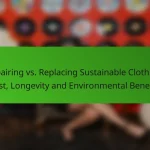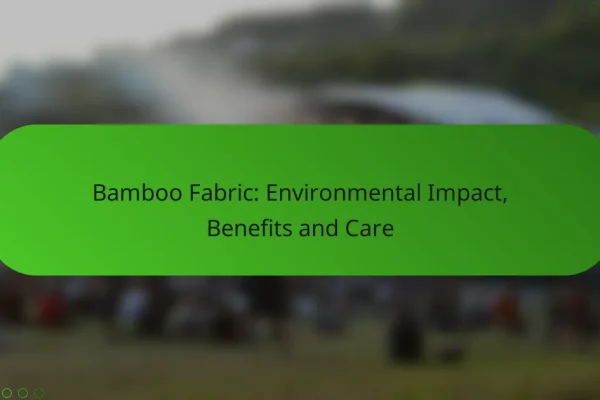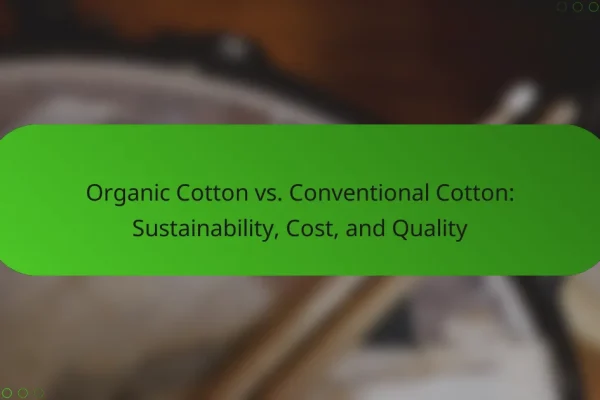What are the best sustainable fashion materials?
The best sustainable fashion materials include organic cotton, Tencel, recycled polyester, hemp, and Piñatex. These materials are chosen for their lower environmental impact and sustainable production processes, making them ideal for eco-conscious consumers.
Organic cotton
Organic cotton is grown without synthetic pesticides or fertilizers, which helps maintain soil health and reduces water usage. It is often certified by standards such as the Global Organic Textile Standard (GOTS), ensuring environmentally friendly practices throughout the supply chain.
When purchasing organic cotton products, look for certifications to ensure authenticity. Brands may charge a premium, but the benefits to the environment and health can justify the cost.
Tencel
Tencel, made from sustainably sourced wood pulp, is known for its softness and biodegradability. The production process uses a closed-loop system that recycles water and solvents, minimizing waste and pollution.
Consider Tencel for its moisture-wicking properties, making it suitable for activewear. It’s also less likely to wrinkle, which can reduce the need for ironing and further conserve energy.
Recycled polyester
Recycled polyester is produced from post-consumer plastic waste, such as bottles, diverting materials from landfills. This process requires less energy than producing virgin polyester, significantly lowering carbon emissions.
When selecting recycled polyester, check for certifications like the Global Recycled Standard (GRS). This ensures that the material meets specific environmental and social criteria.
Hemp
Hemp is a fast-growing plant that requires minimal water and no pesticides, making it an eco-friendly choice. It produces strong, durable fabric that becomes softer with each wash, enhancing its longevity.
Hemp is often blended with other fibers to improve comfort and versatility. Look for brands that highlight hemp in their products to support sustainable agriculture.
Piñatex
Piñatex is a leather alternative made from pineapple leaf fibers, utilizing agricultural waste and reducing the need for animal products. This innovative material is both biodegradable and durable, making it suitable for various fashion applications.
When considering Piñatex, be aware of its unique texture and appearance, which can vary. Brands using Piñatex often emphasize ethical production, so look for transparency in sourcing and manufacturing practices.
How do sustainable materials impact the environment?
Sustainable materials significantly reduce environmental harm by minimizing resource consumption and waste generation. By opting for eco-friendly textiles, the fashion industry can lower its ecological footprint and promote a healthier planet.
Reduced water usage
Sustainable materials often require less water during production compared to conventional fabrics. For instance, organic cotton uses about 90% less water than traditional cotton farming methods. This reduction is crucial in regions facing water scarcity.
Choosing materials like Tencel or hemp can further decrease water consumption, as these fibers are grown with minimal irrigation. Consumers can look for certifications that indicate lower water usage in the production process.
Lower carbon footprint
The carbon footprint of sustainable materials is typically lower due to eco-friendly farming practices and energy-efficient manufacturing processes. For example, recycled polyester can save up to 75% of the energy used in producing virgin polyester.
When selecting clothing, consider brands that utilize renewable energy sources in their production. This not only helps reduce greenhouse gas emissions but also supports a shift towards more sustainable practices in the fashion industry.
Less chemical pollution
Sustainable materials minimize chemical pollution by avoiding harmful pesticides and synthetic dyes commonly used in conventional textile production. Organic fabrics, for instance, are grown without toxic chemicals, protecting both the environment and the health of workers.
Additionally, opting for natural dyes instead of synthetic alternatives can significantly reduce water pollution. Consumers should seek out brands that prioritize eco-friendly dyes and transparent production processes to support cleaner manufacturing practices.
What are the benefits of using sustainable fashion materials?
Using sustainable fashion materials offers numerous advantages, including reduced environmental impact and improved brand image. These materials often come from renewable sources and can enhance consumer loyalty by aligning with their values.
Eco-friendly production
Eco-friendly production refers to manufacturing processes that minimize harm to the environment. This includes using organic fibers, non-toxic dyes, and sustainable practices that reduce waste and energy consumption. For example, brands may opt for waterless dyeing techniques or recycled materials to lessen their ecological footprint.
Additionally, many sustainable materials are biodegradable or recyclable, which contributes to a circular economy. This approach not only conserves resources but also reduces landfill waste, making it a crucial consideration for eco-conscious brands.
Enhanced brand reputation
Brands that utilize sustainable materials often enjoy a stronger reputation among consumers. This is particularly important in today’s market, where transparency and ethical practices are increasingly valued. Companies that commit to sustainability can differentiate themselves from competitors and attract a loyal customer base.
Moreover, a positive brand image can lead to increased media coverage and partnerships with like-minded organizations, further enhancing visibility and credibility in the fashion industry.
Consumer demand for sustainability
There is a growing consumer demand for sustainable fashion, driven by increased awareness of environmental issues. Many shoppers are now willing to pay a premium for products that are ethically produced and environmentally friendly. This trend is particularly strong among younger generations, who prioritize sustainability in their purchasing decisions.
Brands can capitalize on this demand by clearly communicating their sustainable practices and the benefits of their materials. Engaging storytelling and transparency about sourcing and production processes can significantly influence consumer choices and foster brand loyalty.
What certifications should sustainable materials have?
Sustainable materials should ideally have certifications that verify their environmental and social responsibility. Key certifications include GOTS, OEKO-TEX Standard 100, and Fair Trade Certified, which ensure that materials meet specific ecological and ethical standards.
Global Organic Textile Standard (GOTS)
The Global Organic Textile Standard (GOTS) is a leading certification for organic fibers, ensuring that textiles are made from at least 70% organic materials. It covers the entire supply chain, from harvesting to manufacturing, and includes strict environmental and social criteria.
When looking for GOTS-certified products, check for the GOTS label, which signifies compliance with organic farming practices and fair labor conditions. This certification helps consumers make informed choices about the sustainability of their clothing.
OEKO-TEX Standard 100
OEKO-TEX Standard 100 certifies that textiles are free from harmful substances, ensuring safety for human health. This certification applies to all types of textiles, including raw materials, intermediate and end products, and is widely recognized in the fashion industry.
To identify OEKO-TEX certified items, look for the OEKO-TEX label on the product. This assurance means that the fabric has been tested for harmful chemicals and is safe for use, making it a reliable choice for environmentally conscious consumers.
Fair Trade Certified
Fair Trade Certified products ensure that producers receive fair wages and work under safe conditions. This certification focuses on social equity and environmental sustainability, promoting ethical practices in the supply chain.
When purchasing Fair Trade Certified items, you can feel confident that your purchase supports fair labor practices and sustainable development. Look for the Fair Trade label to ensure that your fashion choices contribute positively to the lives of producers and their communities.
How to choose sustainable materials for fashion?
Choosing sustainable materials for fashion involves selecting fabrics that minimize environmental impact while promoting ethical practices. Key considerations include the material’s source, production methods, and lifecycle.
Natural Fibers
Natural fibers, such as organic cotton, linen, and hemp, are often more sustainable than synthetic alternatives. They are biodegradable and typically require fewer chemicals during production. When selecting natural fibers, look for certifications like GOTS (Global Organic Textile Standard) to ensure responsible sourcing.
Synthetic Alternatives
Some synthetic materials, like recycled polyester, can be sustainable options if they are made from post-consumer waste. These fabrics reduce reliance on virgin resources and often have a lower carbon footprint. However, be cautious of the environmental impact of microplastics released during washing.
Innovative Materials
Innovative materials, such as Tencel or Piñatex, are gaining popularity in sustainable fashion. Tencel is derived from sustainably sourced wood pulp, while Piñatex is made from pineapple leaf fibers. These options offer unique textures and are often produced with lower environmental impact compared to traditional fabrics.
Certifications and Standards
Look for certifications that indicate sustainable practices, such as OEKO-TEX, Fair Trade, or the Better Cotton Initiative. These labels help ensure that materials are produced ethically and with minimal environmental harm. Familiarizing yourself with these standards can guide your purchasing decisions.
Local Sourcing
Choosing locally sourced materials can significantly reduce the carbon footprint associated with transportation. Local fabrics often support regional economies and can be more environmentally friendly. Consider exploring local textile markets or artisans to find sustainable options that align with your values.










